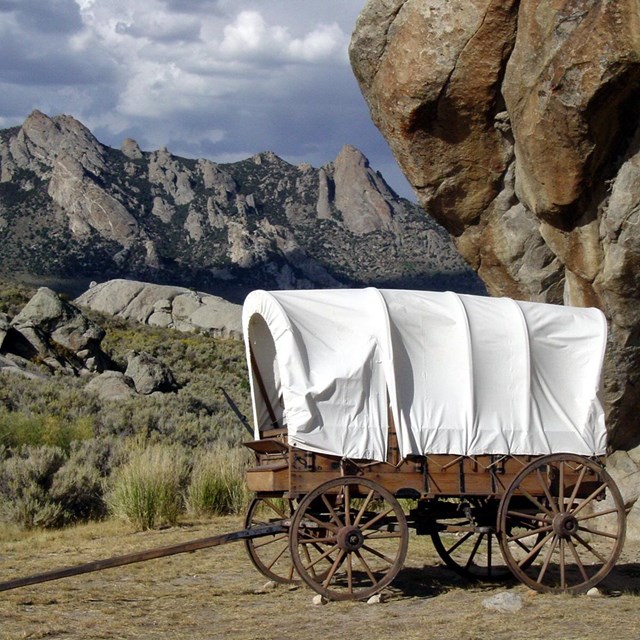Article
Christmas on the Emigrant Trails: Christmas 1846 at Donner Lake, California
Most emigrants reached the end of their long overland journey weeks or months before December 25 rolled around. A few, though, stranded or lost along the way, spent their first Christmas in the West in winter camps many miles from the settlements. Here’s how they observed the holiday.

Image/Public Domain
The 81 members the Donner-Reed Party were much less fortunate than the Walker wagon train. They were on a tried-and-true wagon trail, the 1844 Truckee Route, not lost but late. These emigrants attempted to cross the central Sierra Nevada in early November 1846 but became trapped by blizzards near present-day Truckee, California. Unable to move east or west, they huddled in scattered group-camps beneath shelters of branches, cowhides, and old wagon covers as snow after snow piled up around them. The Breen and Reed families were fortunate to find and share a tiny, leaky cabin, built two years earlier by another stranded emigrant. Everyone had eaten up their supplies, and the men’s efforts to fish, trap, and hunt largely failed. By December, the emigrants were living on boiled bone and strips of ox hides from the dead livestock they dug from beneath the snow.
Eight-year-old Patty Reed, living in the crowded cabin with her mother, her 13-year-old sister Virginia, and two little brothers (as well as the Breen family of nine), wrote about that Christmas Day of 1846 decades later in a letter to a newspaperman:
Christmas Eve came, no stockings to hang, no Santa Claus to come down our chimney in that cold yes starving camp…. Christmas morning came, you could not hear that happy sound “Merry Christmas” ring through the hall…. Our breakfast was ready, a pot of glue…. It was stewed ox hide, but we were pleased to have even that to eat. But as soon as we had gone through this…our poor Mother’s face began to brighten up….
Despite the circumstances, Margaret Reed managed a Christmas surprise for her children: she’d tucked away a piece of tripe (cow stomach), a teacupful of white beans, half a cup of rice, a half-cup of dried apples, and a 2-inch cube of fatty pork.
“When this hoarded store was brought out,” remembered Patty’s sister, Virginia, “the delight of the little ones knew no bounds.” The children watched the cookpot boil, squealing with excitement when a bit of pork, slice of apple, or a bean bobbed momentarily to the surface of the bubbling stew. As she served up their Christmas dinner, Mrs. Reed told her little ones, “Children, eat slowly, for this one day you can have all you wish.”
“So bitter was the misery relieved this one bright day,” wrote Virginia many years later, “that I have never since sat down to a Christmas dinner without my thoughts going back to Donner Lake.”
In the same cabin, Patrick Breen, his wife, Margaret, and their seven children had no such feast. Breen’s diary entry for that date says simply, “Offerd. Our prayers to God this Cherimass morning the prospect is appalling but hope in God amen.”
In a neighboring shelter, 14-year-old Mary Murphy’s family of Latter-day Saints (Mormons) supped on “boild bones and oxtail soup.” Her widowed mother, Levinah, had joined the party to take her three children to unite with Mormons in California. Levinah Murphy turned desperately ill that Christmas night.
Rescuers reached the camps in February 1847. All members of the Reed and Breen families survived. Mary Murphy and two little brothers, ages 10 and 8, also were saved, but their mother was too weak to walk out. The last rescue party was forced to leave Levinah behind to die in camp. All the survivors reached the settlements by the end of April 1847.

NPS Photo
For further reading:
- Breen, Patrick. 1963. Diary. In, Overland in 1846: Diaries and Letters of the California-Oregon Trail, pp. 306-322. Dale Morgan, ed. University of Nebraska Press, Lincoln and London.
- James H.L. 2011. Bruff’s Wake: J. Goldsborough Bruff & the California Gold Rush, 1849-1851. Oregon-California Trails Association, Independence, Mo.
- Koenig, George. 1974, The Lost Death Valley ‘49er Journal of Louis Nusbaumer. Death Valley ‘49ers Inc., Death Valley, Calif.
- McGlashan, C.F. 1902. History of the Donner Party. A Tragedy of the Sierra. 7th Ed. H. S. Crocker Co., Sacramento, Cal. Available free online from Internet Archive.
- Manly, William. 1949. Death Valley in ’49. Borden Publishing, Los Angeles, Calif.
- Murphy, Virginia Reed. 1998. Across the Plains in the Donner Party: A Personal Narrative of the Overland Trip to California. Ye Galleon Press, Fairfield, Wash.
- Stewart, George E. 1962. The California Trail: An Epic with Many Heroes. McGraw Hill, New York, Toronto, and London.
- Werner, Emmy E. 1995. Pioneer Children on the Journey West. Westview Press, Boulder, Col.


